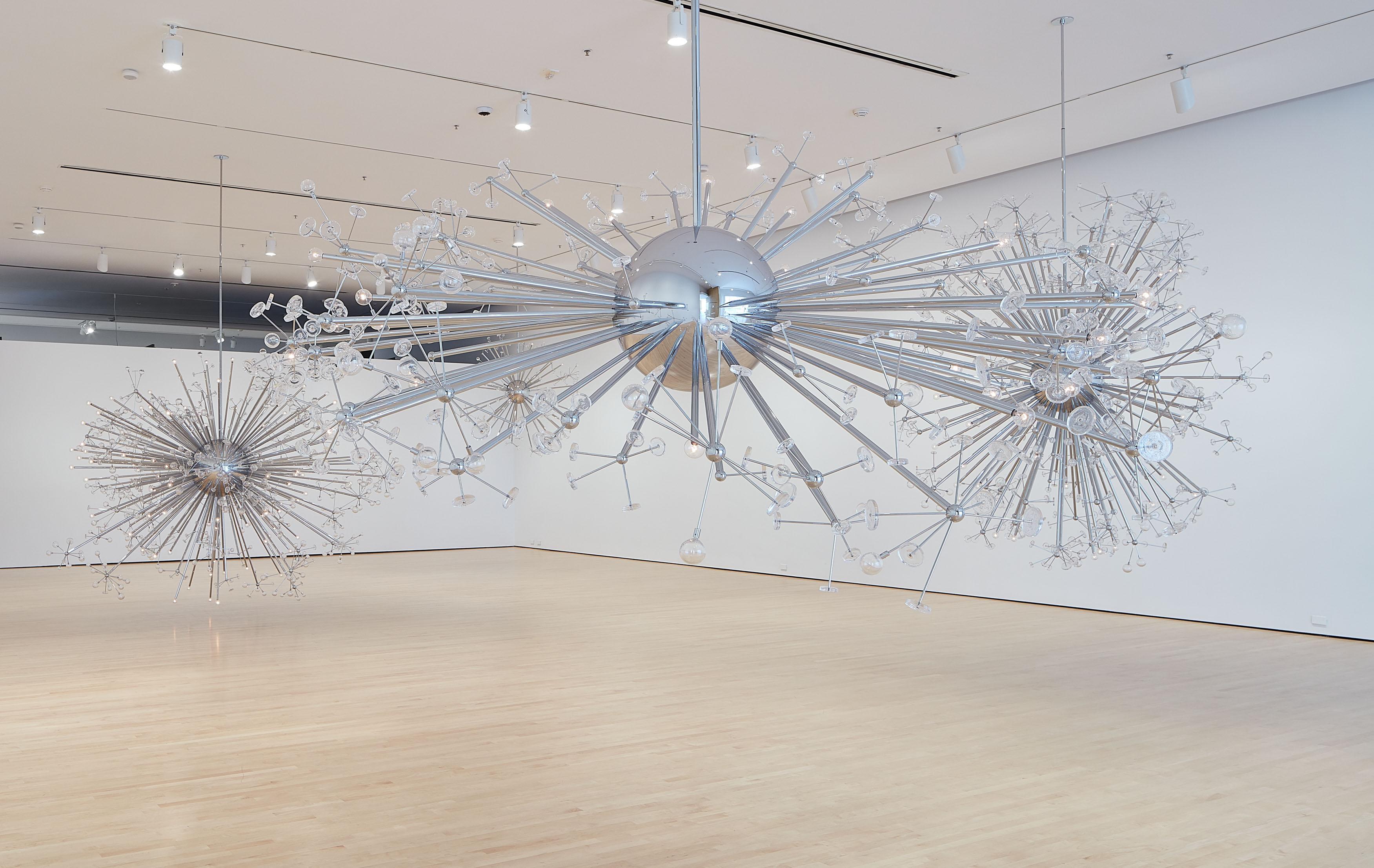February 23–August 18, 2019
Stanford, CA—Josiah McElheny’s monumental installation, Island Universe, made of brilliantly polished chromed metal, handblown glass, and radiating lights, is an attempt to visualize something impossible to see—the big bang. Working at the unexpected intersection of physics, the history of Modernism, and art, McElheny imagines a multiverse scenario, where five separate universes occupy the same space, frozen in their individual moments of expansion.
A marriage of scientific research and aesthetic modeling, McElheny collaborated closely with David Weinberg, distinguished university professor, and chair of the Department of Astronomy at Ohio State University, to make the necessary calculations and conceptualize the installation’s forms. Their collaboration took place while McElheny was a resident at the Wexner Center for the Arts at Ohio State University.
“Bringing Island Universe to the Cantor also is meaningful because the project was inspired by the work of Andrei Linde, a renowned professor in the Physics Department at Stanford,” said Susan Dackerman, John and Jill Freidenrich Director at the Cantor. “My hope is that this exhibition encourages conversations among faculty, students, and the wider community about how art and science can be linked in visually stimulating and surprising ways, and how these two disciplines can inform each other. ”The installation at the Cantor will be the first time Island Universe is exhibited on the West Coast.
In 1965, the first physical evidence of the big bang theory became public, launching popular interest in space science. That same year, artisans in Vienna created the iconic chandeliers of the Metropolitan Opera in New York. The confluence of those two events inspired McElheny, who many years later modeled Island Universe on the chandeliers but also incorporated the notion of an expanding universe with the careful placement of the metal spheres, glass disks and globes, and lights that make up the work.
The glass disks and globes that are part of Island Universe were hand-blown by the artist, who is recognized for his conceptually rigorous approach and his physical mastery of materials.The 2006 MacArthur Fellow once said that using glass in his work gives a unique perspective not because the glass itself is important, but because of what viewers see through it.
In the case of Island Universe, viewers might feel as though they’re able to see the beginning of time.
Related Programs
Josiah McElheny in Conversation
March 2, 2019, 2 PM
Island Universe creator Josiah McElheny will be in conversation with David Weinberg, distinguished university professor, and chair of the Department of Astronomy at Ohio State University. McElheny collaborated with Weinberg to make the necessary calculations and conceptualize his installation’s forms.
Case Studies
Focusing on one particular object on view, Case Studies is a series of public conversations between art historians and faculty from other disciplines designed to facilitate critical inquiry and cross-disciplinary discourse on the visual arts. During winter quarter 2019, Case Studies will be devoted to Josiah McElheny’s Island Universe. Faculty from both the humanities and sciences on campus will discuss this monumental work, which was inspired by renowned Stanford physicist Andrei Linde’s theory of the multiverse.
Gallery Talks
Visitors are invited into the gallery to learn more about these visually stunning and monumental sculptures that map the history of time.
This is exhibition is organized by the Cantor Arts Center. We gratefully acknowledge support from the Halperin Exhibitions Fund, the Robert Mondavi Fund, The Clumeck Endowment Fund, the Elizabeth Swindells Hulsey Exhibitions Fund, and the Contemporary Collectors Circle.
Cantor Arts Center at Stanford University
Founded when the university opened in 1891, the museum was expanded and renamed in 1999 for lead donors Iris and B. Gerald Cantor. The Cantor’s collection spans 5,000 years and includes more than 38,000 works of art. With 24 galleries, more than 15 special exhibitions each year, and free admission, the Cantor is one of the most visited university art museums in the country, attracting visitors from the area and around the world.
Visitor Information
The Cantor Arts Center is open six days a week, and admission is free. Hours: Wednesday–Monday, 11 AM–5 PM, and Thursday until 8 PM. The museum is closed on Tuesday. The Cantor is located on the Stanford campus, off Palm Drive at Museum Way. Parking is free after 4 PM weekdays and all day on weekends and major holidays.
For more information, call 650-723-4177or visit museum.stanford.edu.
Instagram: @cantorarts Twitter: @CantorArts Facebook:/CantorArtsCenter

